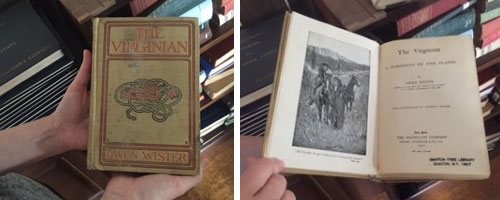Here to Stay: Print media in North Country libraries
Not long after the invention of the printing press, Sir Francis Bacon introduced his gastronomic theory of books: “Some books are to be tasted, others to be swallowed, and some few to be chewed and digested.” What if the great philosopher sunk his teeth into an eBook? Would an online-only publication upset his stomach?
Our access to information has changed. Print books no longer reign supreme. Over the past few decades, digitized media have changed the reading experience. Will print books soon be a thing of the past?
For most librarians, the answer is no. North Country libraries continue to lend out print books as they have for years. Emily Owen, director at the Canton Free Library, explained the availability of new media has not forced print books off the shelves. “Print use is still strong here and eBooks are still being used as well,” she said.
Paul Doty, a Public Service Librarian at St. Lawrence University’s Owen D. Young Library, said the research-oriented college library still maintains a vast print collection for practical reasons. “The book is too efficient a means for storing information,” Doty said. “It’s terrifically useful, it’s terrifically long-lasting, [there is] a lot of literature to suggest that many electronic formats actually are very transitory. They break down in a relatively short period of time where, obviously, we have books that date back centuries.”
Libraries use a hybrid system these days. Electronic sources may have made the research process easier, but print books remain a favorite for those with an appetite for paper and ink. Doty said past thinkers predicted this coexistence between media. “A guy named J. C. R. Licklider, he very much in his writings—some of his most important writings—really saw a coexistence between print media and digital media. And so yes, I think there is a real coexistence between the two media. However, I think that the reading experience offline is often a much more powerful experience without having to be deliberate about it. Just the relationship we have with books and the physicality of reading a print book can very often lend itself to the kind of sustained concentration that is very difficult when you are online,” Doty said.

Print books and computers live side by side in Owen D. Young Library. Photo: Joey Duggan
Both Owen and Doty agree print media will stay in circulation for practical reasons. In his experience as a Research Librarian, Doty has found print books help readers digest what they read. “It’s enduring,” said Doty. “The experience reading a physical book, a print book, is one that allows [readers] to interact with the text more intensely, have a better sense of recall, have a more holistic experience interacting with the text, and thus be more forcefully changed by their reading than they might be encountering text online.”
Print media has far-reaching effects. Sarah Sachs, a librarian at the Potsdam library, points to an ongoing debate about print media. She said although many specialists are reconsidering the role of electronics in childhood development, books remain the tried and true method for teaching children how to read. In other words, if you can still read the words on the page, why rewrite them?

The Canton Free Library still keeps books that date back to its foundation in the early 20th Century, including this copy of The Virginian. Photo: Joey Duggan
Although readers still have a taste for turning pages, demand for print media by library patrons does not directly determine the contents of a library’s catalog. Librarians try to curate collections that accommodate their patron’s preferences, but Owen explained she can only offer resources based on forces outside of her control.
“A lot of the issues that libraries experience with print versus e-media are really about the publishing industry and print versus e-media,” Owen said. “Because we only have access to what is published and available to us, libraries are kind of at the mercy of the publishing industry in that way. Magazines sometimes ceased publication in print, or at least ceased to be available to a library in print. And that was sort of a decision by those companies, and it wasn’t necessarily related to what people wanted to read, because we’ll still have people who want to read a print magazine, but we just can’t get it for them anymore, so we get an e-version of it, and they’ll still get used, but it wasn’t a choice of people moving away from print, it was that the print wasn’t available.”
Owen said, “It can go the other way, too. There can be stuff that’s not available in an e-version, and people might prefer to read it in an e-version.”
Libraries rely on publishers in order to stock their shelves with new materials, but librarians seem to agree print media is not going anywhere. Those of us who appreciate a good page turner can rest easy knowing we will still have pages to turn.










Printed books will always be the mainstay of libraries, largely due to borrowing an ebook from a library really sucks and you can get thousands for free or a low price without bothering to leave your home.